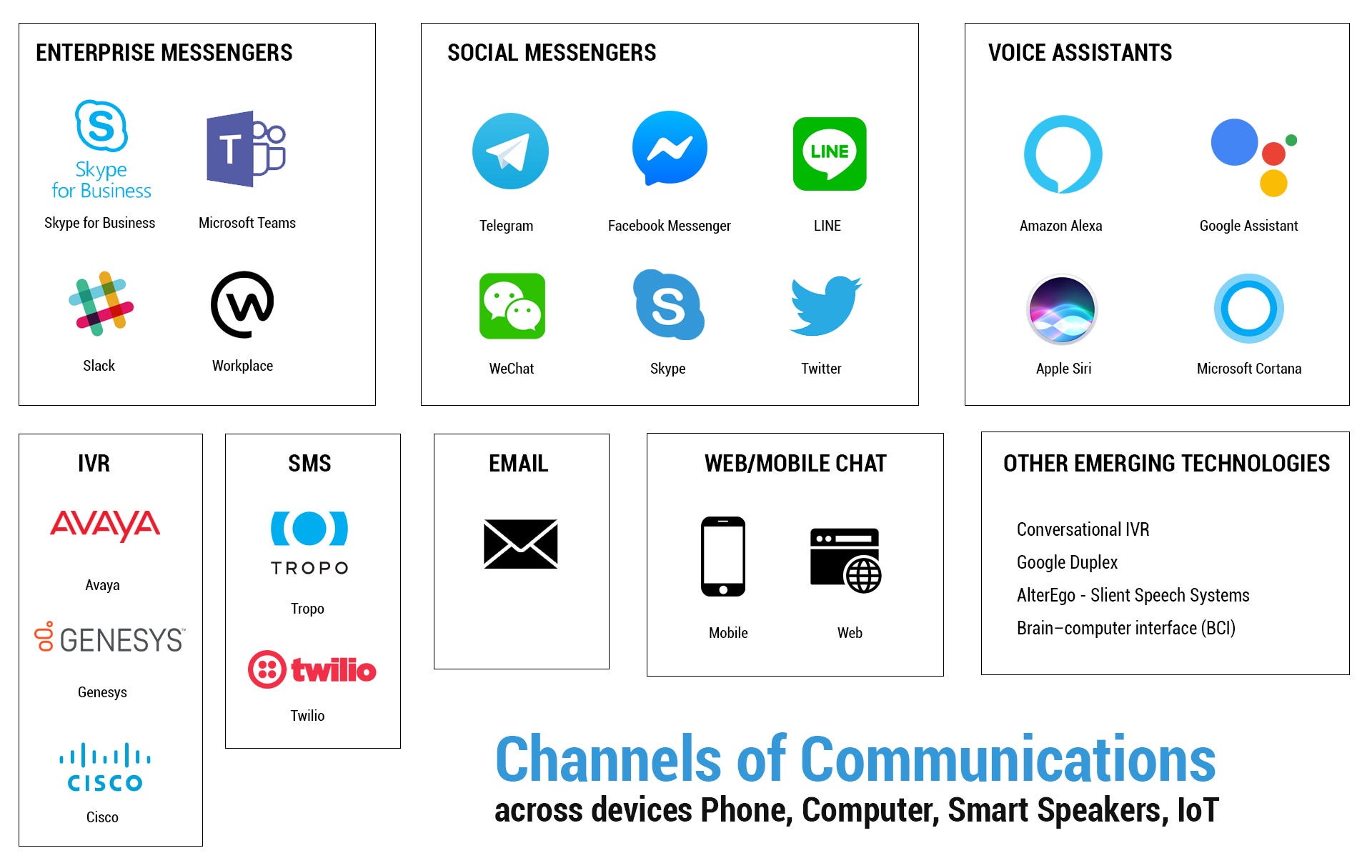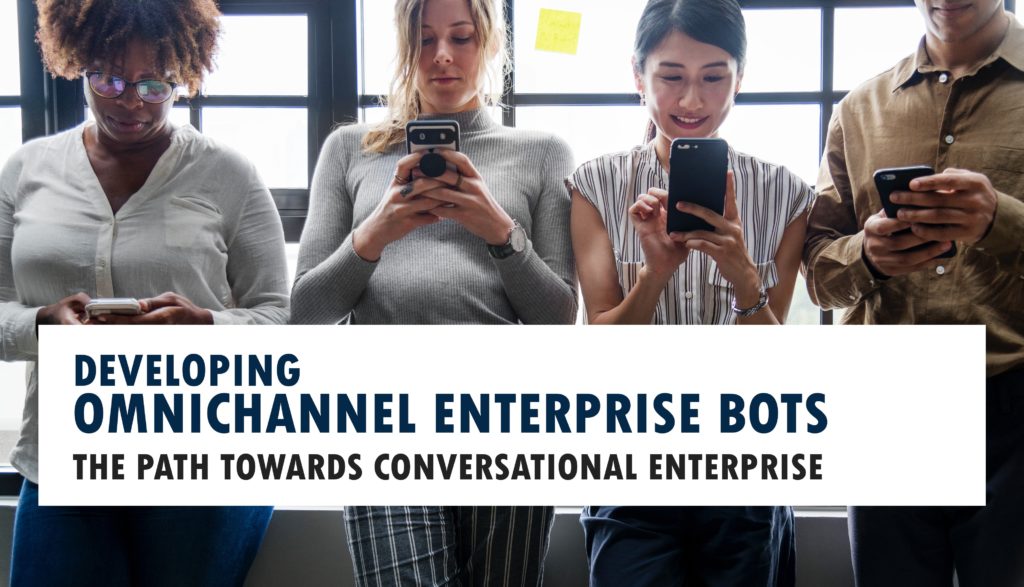As enterprises continue to churn out massive amounts of data every day, insight-driven decision-making has become a distant dream. A chatbot will be a popular solution among enterprise that offers a conversational experience using artificial intelligence and natural language processing to mimic conversations with real people. A conversational enterprise integrates Conversational AI into their internal and external workflows.
According to Gartner, by 2021, more than 50% of enterprises will spend more per annum on bots and chatbot creation than traditional mobile app development. Also, by the year 2021, Gartner reports that “conversational AI-first” user experience, or CUX, will be adopted by most enterprise organizations.
It’s not just limited to chatbots, by 2020, 30% of web browsing sessions will be done without a screen. This means that there is going to be an increase in the adoption of Voice Assistances such as Google Assistant, Alexa, Cortana, etc.
According to Juniper Research, chatbots will be responsible for cost savings of over $8 billion per annum by 2022. The adoption of chatbots highly depends on how appealing they would be to the end users and omnichannel enterprise bots is the latest fad in the industry.
What do you mean by Omnichannel Enterprise Bots?
Omnichannel means multiple channels of communication with the bot. Channels are where the conversations happen. It’s the connection between the bot code and communication app. Some of the popular communication channels in the enterprise include Skype for Business, Slack, Microsoft Teams, SMS, Email, etc. Channel is not just limited to messaging apps and can extend to voice assistants such as Google Assistant, Amazon Alexa, Microsoft Cortana and extend to devices like Mobile, Desktop/Laptop, Smart Speakers and Phone/IVRs.

Thus, an Omnichannel Enterprise bot means seamless interaction where the user will have a single user journey no matter which platform they use. In the world where businesses become more and more client-centric, it is very important that all platforms are united around the user.
Different technologies enable omnichannel, but users don’t really care about technologies. They just want their issue to be solved effectively and quickly, without any effort from their side.
Developing Omnichannel bots are not an easy task. There is no bot platform presently available to build bots across all the popular messaging app. E.g. You can’t build a chatbot for Skype for Business using DialogFlow (formerly Api.ai, Speaktoit) and can’t integrate Google Assistant using Azure Bot Services. Replicating the same conversations across platforms is a major challenge today. Some channels don’t support “Suggestion Chips” or “Cards”. Thus, the development of omnichannel bot is of great complexity and is no easy challenge as both customization and personalization is a key challenge.
The Challenges
The challenge starts with omnichannel. Users have multiple ways for reaching out to you and chatbots in an enterprise are yet to be adopted mainstream. Enterprise-grade Omni-bots have unique specifications and requires strong compliance. Here are some of the major challenges experienced to develop omnichannel enterprise bots:
1. User Experience
User experience remains the paramount factor for an enterprise, a high accuracy of response is key to adoption in the enterprise. For a bot to converse with humans successfully, the bot must have natural language processing (NLP) capabilities. This is the brain of the bot — understanding natural language, analyzing user utterances, identifying intents, extracting entities and performing tasks.
Machine learning needs to come into play to understand synonyms, patterns, and ontologies which enrich the bot’s ability to correctly identify user intents. There are still challenges for NLP systems to understand the context and the absence of labeled data to train models makes it even more difficult.
Some organizations develop the “Hybrid approach” — which helps reduce cost, keeps the user experience optimal, and lets enterprises leverage their support agent. In the Hybrid model, whenever the chatbot is not able to answer the user’s query, the bot can switch to a human who can assist in answering the query and then hand them back to the chatbot to continue their journey. This is an effective one, however challenging in omnichannel. If the user were to use a Voice Assistant, how would the voice assistant talk back? In a Conversational IVR, Is it possible for a human agent to talk in between conversations? These are some of the challenges that are yet to be solved and some developers have a workaround for the same.
2. Architecture
When it comes to enterprise bot’s development, many organizations foresee productivity gains of utilizing bots across the enterprise. In many cases, a department would create a bot as a proof of concept that turns out to be a success and other departments quickly see value in applying bot technology to their domain. However, this can lead to issues if there is not a cohesive enterprise bot strategy and architecture in place.
There are 5 consideration when you design an omnichannel bot
- Can the bot easily solve the user’s problem with the minimum number of steps?
- Can the bot easily solve the user’s problem with the minimum number of steps?
- Can the bot solve the user’s problem better/easier/faster than any of the alternative experiences?
- Can the bot be integrated with application and backend systems? How fast can change be made?
- Is the bot available across the channel the user cares about?
- Is the bot discoverable? Do users naturally know what to do when using it?
These questions may not be related to architecture but have serious implications in the design of the bot. Multilingual capability is a preferred feature for global enterprise bots. Bots are employed to get tasks done. Tasks can be of various types such as creating a service request, sending notifications based on user-defined events, answering questions from knowledge bases, fetching reports and performing complex tasks involving complex logic and multiple systems. The bot architecture must consider for all these activities to be included and should have the framework to interconnect with enterprise interfaces for data exchange.
3. Administration & Management
Administrating an omnichannel bot is critical for the success. An omnichannel bot requires a robust platform to not only develop and train bots, but also to test (unit tests, integration tests, regression tests, and functional tests), publish, and manage the bots throughout their life cycle, including versioning and upgrading. Testing includes the platform’s ability to analyze user utterances that successfully resulted in task completion and separating the utterances that failed to recognize intents or resulted in incomplete tasks. It also includes the compatibility of conversation across channels.
A proper change management system is required to understand the impact of upgrades and updates to the code. When bots are used by various departments within an organization, proper tracking mechanisms and centralized control for deployments is a key factor. This also includes the ability to manage conversations — a middleware for storing, formatting and transforming content and fulfillment of actions. All the activities and events must be presentable in dashboards for detailed analysis which would assist in the improvement.
4. Security, Compliance & Risks
Enterprises, as well as users, take bot security a top priority. This also means compliance with information security standards such as GDPR, HIPAA, SOC 2, etc. Robust security practices must be adopted which includes encryption across all layers including authentication and authorization mechanisms. To ensure that the bot is compliant, it’s essential to include it as part of the design phase. When your bot is Omnichannel, it’s not just text data that you store, but also voice data and other personal and commercially sensitive data.
Sutherland JOE (Joint Omnichannel Engagement)
Sutherland is a process transformation company focused on helping Fortune 1000 companies rethink the way business gets done. Sutherland rethinks and rebuilds processes for the digital age by combining the speed and insight of design thinking with the scale and accuracy of data analytics. Headquartered in Rochester, N.Y., Sutherland employs thousands of professionals spanning 20 countries around the world.

JOE is a virtual agent developed by Sutherland for employees to interact with ServiceNow® and other native applications at Sutherland. The bot interacts with ServiceNow®, a service management tool to create tickets and resolve issues at a faster rate. E.g. If a user wants to create a Service Request, the user can type “I want to install a software?”, the bot would reply asking for the name of the software and for the business justification. Once the required information is collected, the bot would process the request and post it to ServiceNow. ServiceNow workflows automate the process of approvals and fulfillment of the request. Once the approvals are done, the software would be automatically be installed in the system.
It’s also connected with Sutherland’s Internal Knowledge Base on IT and HR Policies. E.g. If a user asks, “What is the process to claim accident insurance?”, JOE would reply with the process for the same. What makes JOE unique is also the fact that it supports localization. Sutherland is an organization that is spread across multiple geographies. Henceforth, the process & policies vary based on geographies. JOE would be able to figure out the location of the user and then reply accordingly.
JOE also has the capability to pull up reports and give information — ongoing outages, a status update on the ticket and talk about various functions within the organization. Today, JOE is integrated with Skype for Business, Microsoft Teams, Google Assistant and would be available across multiple platforms.
Conclusion
Omnichannel bots have great potential to help businesses save money, increase the effectiveness of communications and increase customer loyalty. All of this results in bigger sales and greater advantage among competitors.
Soon they would become a must-have solution for any business that wants to stay relevant on a market that’s changing at a crazy pace. Early adoption of chatbots can help businesses to gain the necessary experience and therefore become one of those companies that can provide truly omnichannel experience for their customers.

